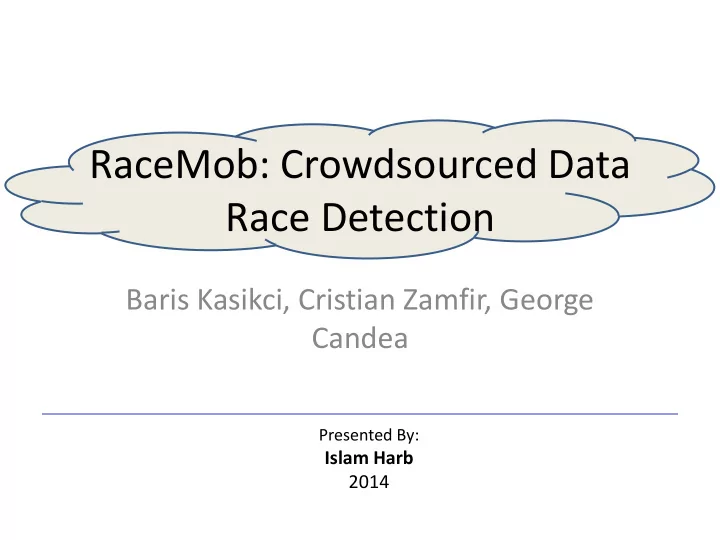

RaceMob: Crowdsourced Data Race Detection Baris Kasikci, Cristian Zamfir, George Candea Presented By: Islam Harb 2014
Agenda • Motivation • Data Race Detection Classes • RaceMob • Implementation • Evaluation 1
Motivation (The Problem?) • Data races as a problem of the concurrency. • Data races are represented in – Atomicity (e.g. access same memory location at same time). – Order violation (e.g. bad pointers). • Difficult to discover. Usually requires significant overhead. 2
Few is Many • Although only 5-24% of data races have harmful effect(s), their consequences were Catastrophic. • If I am a top coder, why would I worry? – C/C++ standards allow compilers’ optimization that might lead to data races. • Therefore, data race detectors are highly recommended. 3
Static Data Race Detection • Static Detection: Analyze the code without execution. (Reasoning) • Pros: – Offline (No runtime overhead). – Fast and Scale to large code bases. • Cons: – False Positives (unreal data races). 4
Dynamic Data Race Detection • Dynamic Detection: Monitor memory access and synchronization at runtime . • Pros: – More accurate (very low FPs rates). • Cons: – Test Cases depended. Miss data races that aren’t seen during execution (False Negative) – runtime overhead. 5
RaceMob • Combines static and dynamic detections to obtain both accuracy and low runtime overhead. • RaceMob is a three-phased detector. – First, static detection phase (potential races with few false negatives). – Dynamic phase. – Crowdsources the validation phase to users machines. 6
Static RaceMob [Phase I] • The static phase of the RaceMob is done via the RELAY. • RELAY is a “lock - set” data race detector. • Data race is flagged when: – At least two accesses to memory locations that are the same or may alias. – One of the accesses is write. – The accesses are not guarded by at least one common lock. • Based on RELAY report, RaceMob instruments all suspected memory access and synchronization operations. 7
Dynamic RaceMob [Phase 2] • The Dynamic phase of the RaceMob. • The hive instructs and distributes the validation task through the users sites. • Dynamic phase itself is consisted of there phases: 1. DCI: Dynamic Context Inference [Always ON]. 2. On-Demand Data Race Detection [ON/OFF]. 3. Schedule Steering [ON/OFF]. 8
DCI: Dynamic Context Inference • Looks for concrete instances at runtime at the users machines. • The concrete instances should validate the candidate data race and confirm on whether the racing accesses are made by two different threads. • DCI, keeps track of addresses of potential racing accesses and the Thread’s ID . • Negligible runtime overhead (0.01%), there feasible to be always ON. 9
On-Demand Data Race Detection • Starts tracking the happens-before relationships once first potential racing access is made. • Stops tracking: – “happens - before” occur between first accessing thread and all other threads. [No Race] – Second racing access occur before such “happens - before”. [ True Race] 10
Schedule Steering • Hive instructs one of the orders (“primary” or “alternative”) to be validated. • RaceMob may pause the accessing thread with “wait” operation to enforce the intended order. 11
Crwodsourcing Overview [Phase 3] • Crowdsourcing the validation. 12
RaceMob: Reaching Verdict • True Race is definite. – Should get a proof from any of the user-sites! • Likely False Positive is probablisitic. – The more “No Race” & “Timeout” reports, the more probability that it is False Positive. 14
Implementation • 4,147 C++ Lines of Code. • 2, 850 Python – Hive and user-side daemon. • Used C++11 weak atomic store/load operations. • Hive is based on LLVM 15
Empty Loop Optimization • Empty loop bodies caught and suspected as a data race candidate: While(notDone){} – Not instrumented. – Reported directly to the developer by the hive. – Never reach to the user-sites for further validation. – Otherwise, excessive overhead encounters. 16
Evaluation • Does it work on Real Code (Real Applications)? • Efficient? • RaceMob vs. state-of-the-art? • Scale with No. of threads? 17
Test Environment • Small scale real deployment on Authors laptops. – Thinkpad Laptops, Intel 2620M Processors, 8 GB RAM, Ubuntu Linux 12.04. • 1, 754 simulated users sites. • Test Machines: – 48-core AMD Opteron 6176 (2.3 GHZ), 512 GB RAM, OS: Ubuntu Linux 11.04 [Simulated Users] – Two 8-core Intel Xeon E5405, 20 GB RAM, OS: Ubuntu 11.10 [Hive + Simulated Users] 18
Applications • SQLite • Bzip2 • Memcached • Ocean • Fmm • Barnes • Apache • Others 19
Evaluation • ~13% (106 ) True Race. [don’t forget: Few is Many!] • 77% are Likely FP • No False Negative. 20
Overall Overhead • Less runtime overhead. • Static Stage is Offline ~3 minutes for all programs, except for Apache and SQLite ~ less than 1 hour. 21
Instrumentation vs. Validation • Overhead = Instrumentation + Validation -Instrumentation overhead is negligible with respect to the Validation overhead -DCI is negligible ~0.1% - Dynamic Data Race is the black portion. [Lion Share] 22
Comparison State-of-the-Art • RaceMob, RELAY and TSAN • RaceMob detected 4 extra True Races than TSAN 23
Comparative Overhead 24
Schedule Steering is Significant • RaceMob’s Schedule Steering plays very important role. • SQLite & Pbzip2: – When NOT instrumented – 10,000 executions but no “hang”. – When instrumented (SS is ON) – 3 hangs in 176 executions. • Pbzip2: – When NOT instrumented – 10,000 executions but no “crash”. – When instrumented (SS is ON) – 4 crashes in 130 executions. 25
Concurrency Testing Tools 26
Concurrency Testing Tools (continued) 27
Big Size Problems • How this affect on scalability? – 10 MB file – concurrent requests [Apache & Knot] – Insert, modify & remove 5,000 items from database & object cache [SQLite, Memcached] – Similarly, enlarge problem size in Ocean, Pbzip2 and Barnes. 28
Application Threads Scalability • Scalability Experiment: – Varied threads No. from 2-32. – RaceMob runs on 8-core machine. 29
Thanks! Any Questions? 30
Recommend
More recommend